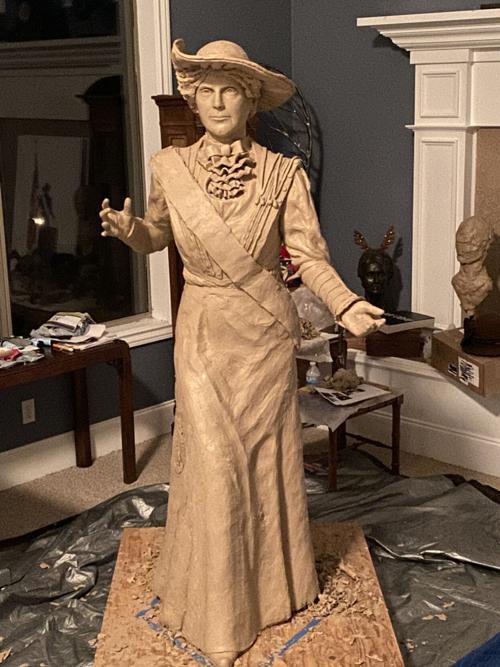August is National Women’s Suffrage Month and Arizona could not have asked for a better person to lead the way in the suffrage movement than Frances Lillian Willard Munds.
Although she was petite in stature, her fiery red hair portended Frances’ driving ambition to take the reins of her life early on and never allow anyone to stand in the way of her beliefs or her ambitions.
One of 12 children, Frances was born to Mary and Joel Willard on June 10, 1866, in Franklin, California. At the age of 15, she set off alone across the continent to attend the Pittsfield, Maine Central Institute, not returning to her family until she graduated in 1885. By then, her father had died and her mother had settled in Arizona’s Verde Valley where Frances’ brothers ran a cattle ranch.
For several years Frances taught school in Payson, Pine, and a Jerome school that was located in an old saloon frequently visited by prior patrons. She met cattleman John L. Munds and the couple married on March 5, 1890. They eventually moved to Prescott when John became deputy sheriff and later Yavapai county sheriff. Frances and John had three children.
Frances became involved with many of Prescott’s civic organizations including the newly established suffrage association.
In 1891, Josephine Brawley Hughes (see March 2015 Western Women column) had founded the Arizona suffrage movement and by 1903, Frances was serving as secretary of the Arizona Equal Suffrage Association. She presided over the organization from 1909 until 1912.
The Arizona Equal Suffrage Association was instrumental in pushing a suffrage bill through both the Arizona House and Senate in 1903, but then territorial Governor Alexander Brodie vetoed the bill. Anticipating they had enough votes to override the veto, women filled the state capitol gallery to witness what turned out to be a resounding defeat as members reversed their earlier votes.
Frances, calling Brodie an “old fool,” jokingly admitted she and the organization “were so vexed with him we almost felt like doing him violence.” Instead she straightened her decorative, feathery hat, one of many she fancied throughout her life, and set her sights on women gaining the vote as Arizona headed toward statehood.
Frances worked diligently to get men sent to the 1910 constitutional convention who supported women’s suffrage. A new Labor Party had materialized with Frances on their doorstep encouraging its delegates to include suffrage with their platform. But when the convention convened on Nov. 2, she knew the suffrage issue was doomed because it was considered “a dangerous and radical thing” and might prevent President William Howard Taft from ratifying Arizona’s bid for statehood.
As Frances and her team celebrated Arizona becoming a state on Feb. 14, 1912, without equal rights for women, they were already working on the November elections to get the suffrage platform on the ballot. Adjusting her latest flamboyant hat, Frances declared “every precinct will be organized. Every chance to spread the suffrage gospel will be grasped. Every woman will be urged to take her part in securing equal suffrage for Arizona.”
She worked tirelessly to sway votes in favor of the suffrage issue. A huge banner was hung across Central Avenue in downtown Phoenix shouting “Votes for Women.” She trudged from county to county trying to convince men that women deserved the right to vote. By election day she was exhausted but continued to distribute suffrage materials as voters came to the polls.
On Nov. 5, 1912, Frances and her team achieved not only victory but garnered a whopping majority of the vote for suffrage. At the time, it was the largest vote for suffrage in the country. Arizona was the eighth state to grant women the right to vote.
In a letter that was published in newspapers around the state, Frances praised the women who were instrumental in fighting for their rights. “I hope you will band yourselves together,” she wrote, “regardless of political, religious or personal differences and make a study of the laws that govern women and children.”
She went on to “thank the generous, progressive men of Arizona, who are the right sort of fathers, husbands, brothers and sons. And don’t be too hard on those who voted ‘No,’ on the suffrage amendment,” she admonished. “They did not intend to be mean. They were only foolish.”
In 1914, Frances was in the political arena again, winning a seat in the Arizona Senate representing Yavapai County, only the third woman in the country to hold a state Senate seat. And while she did not speak often on the Senate floor, when she did she was forceful and effective. As one newspaper reported, Frances “has the courage of her convictions and when she has anything to say she does not want for words.”
Two bills that Frances adamantly supported and worked to pass during her tenure were to raise the minimum age to marry and to increase the widow’s tax exemption. The age of consent bill, raising the marriageable age to 16 for women and 18 for men, passed in 1919. The widow’s benefit was also approved.
In 1918, Frances ran for Arizona secretary of state but was defeated in the primaries as male politicians feared a woman in the position might attain the governorship if something happened to the then presiding governor. She retired from politics and spent her remaining years with her family in Prescott. Frances died Dec. 16, 1948 at the age of 82.
In 1982, Frances was inducted into the Arizona Women’s Hall of Fame and there is now a Suffrage Statue Campaign working to have her statue placed in Wesley Bolin Memorial Plaza at the state capitol. The bill has been passed and all that remains is raising funds for the statue that has been designed by Arizona artist Stephanie Hunter. Frances, sporting one of her legendary hats, will be holding the American flag with a ballot box at her feet ready to receive her vote.





